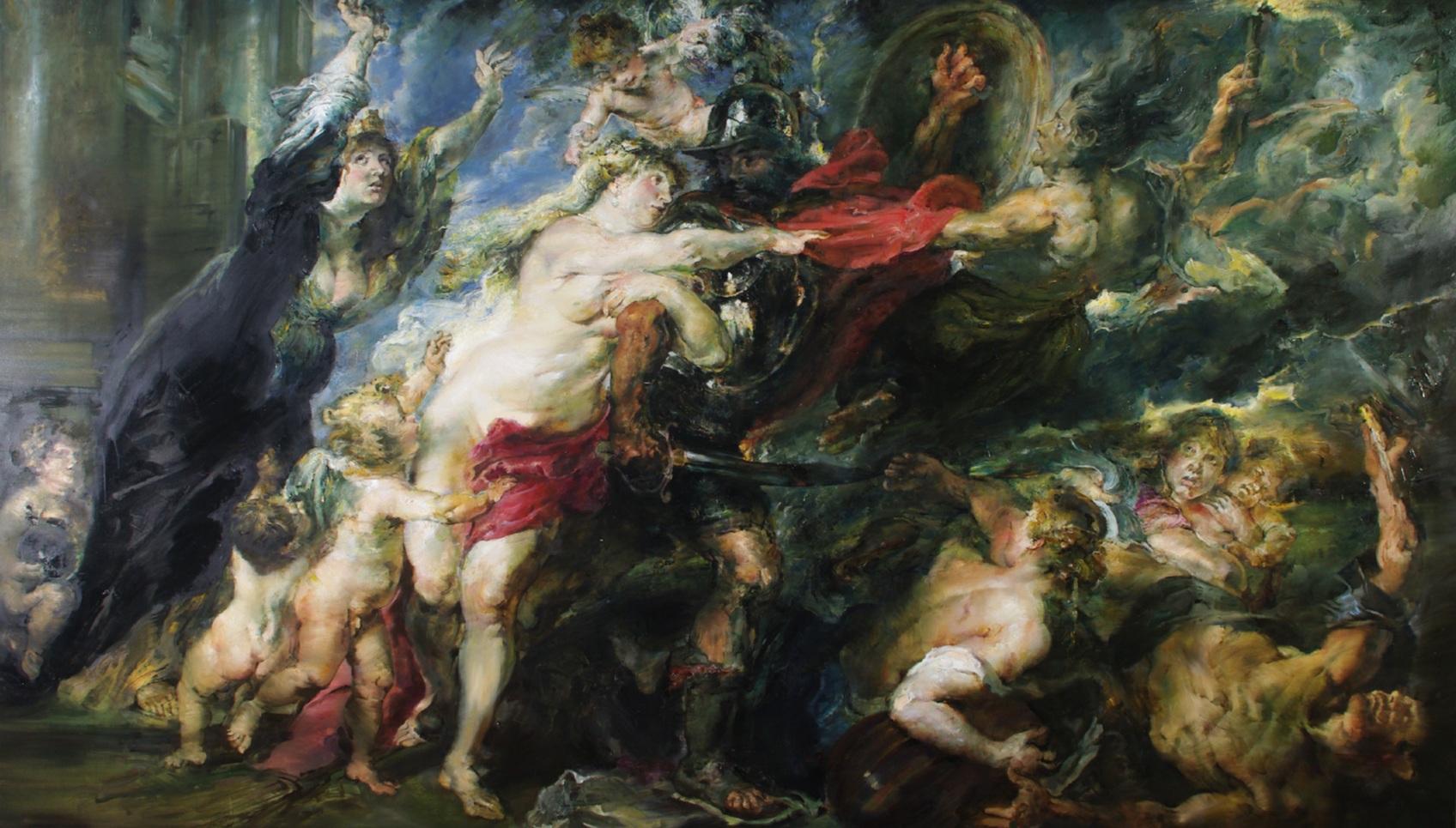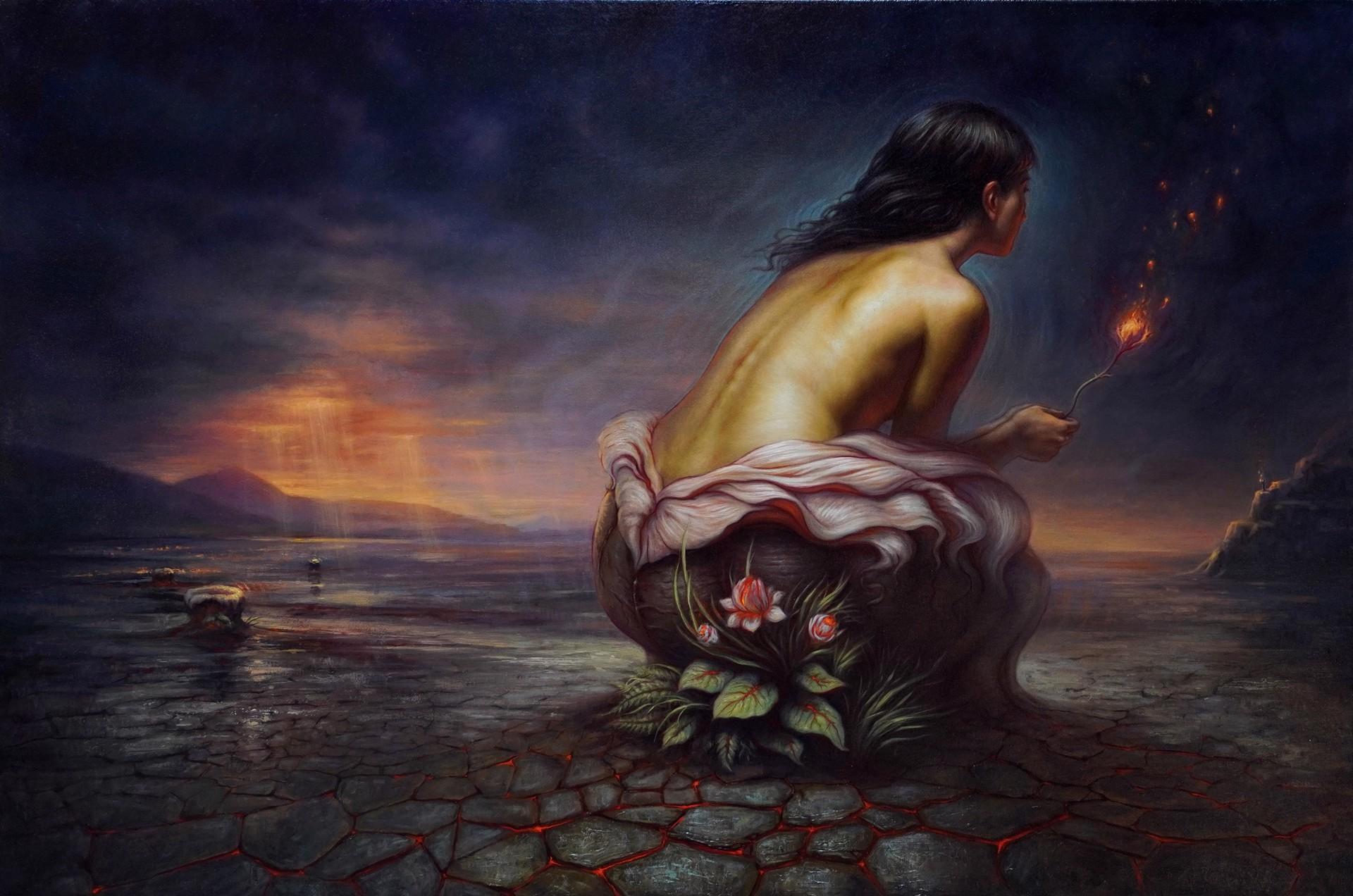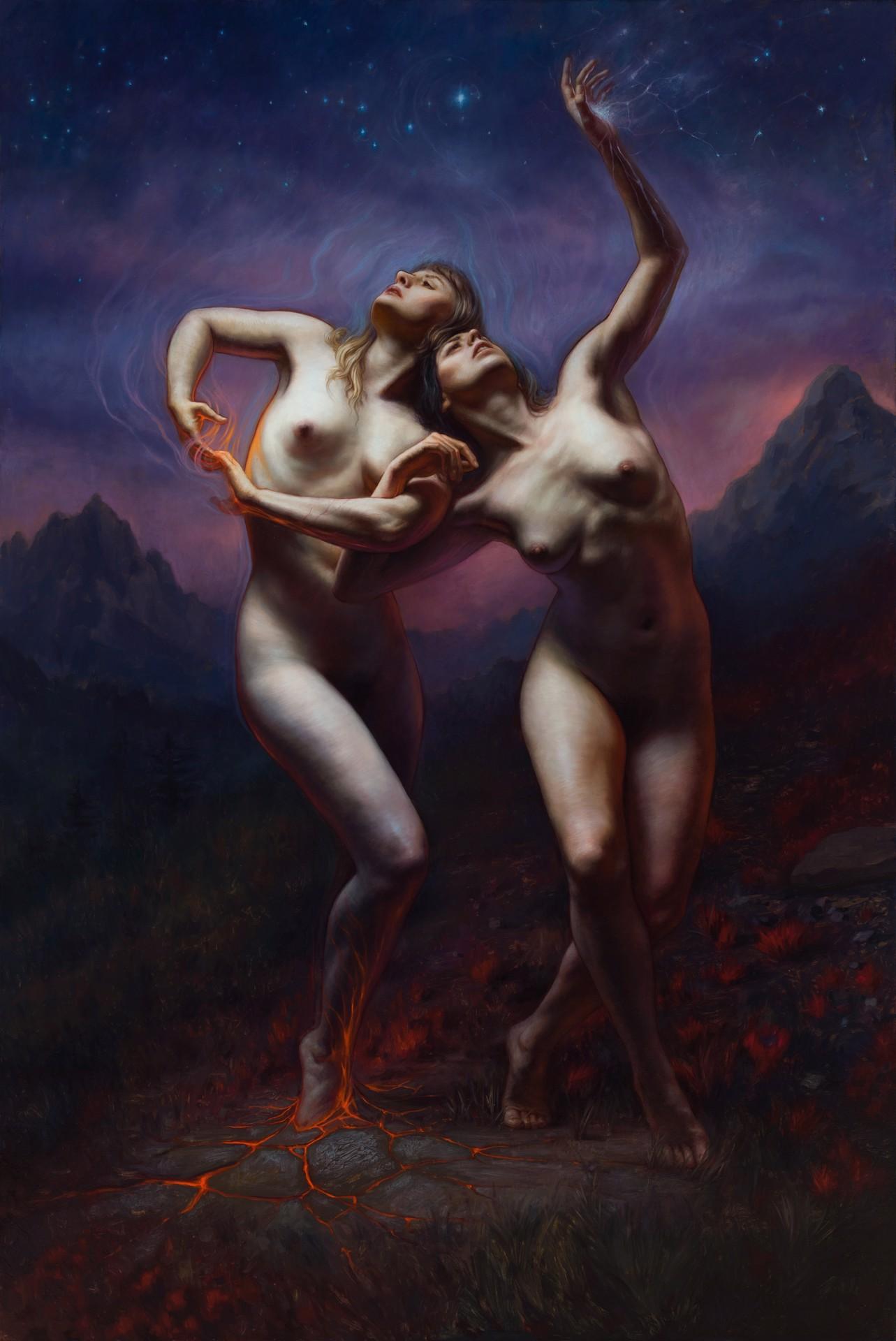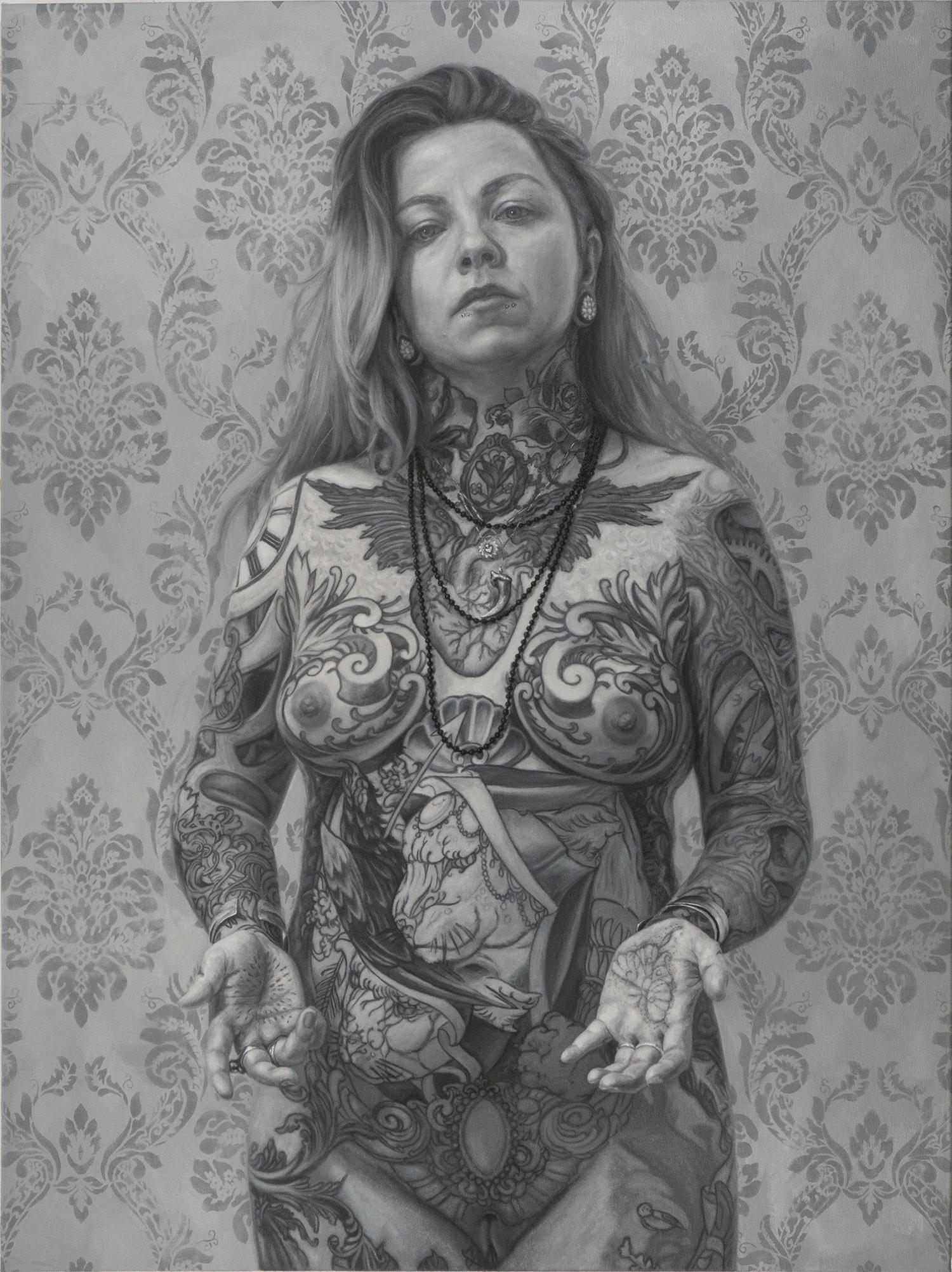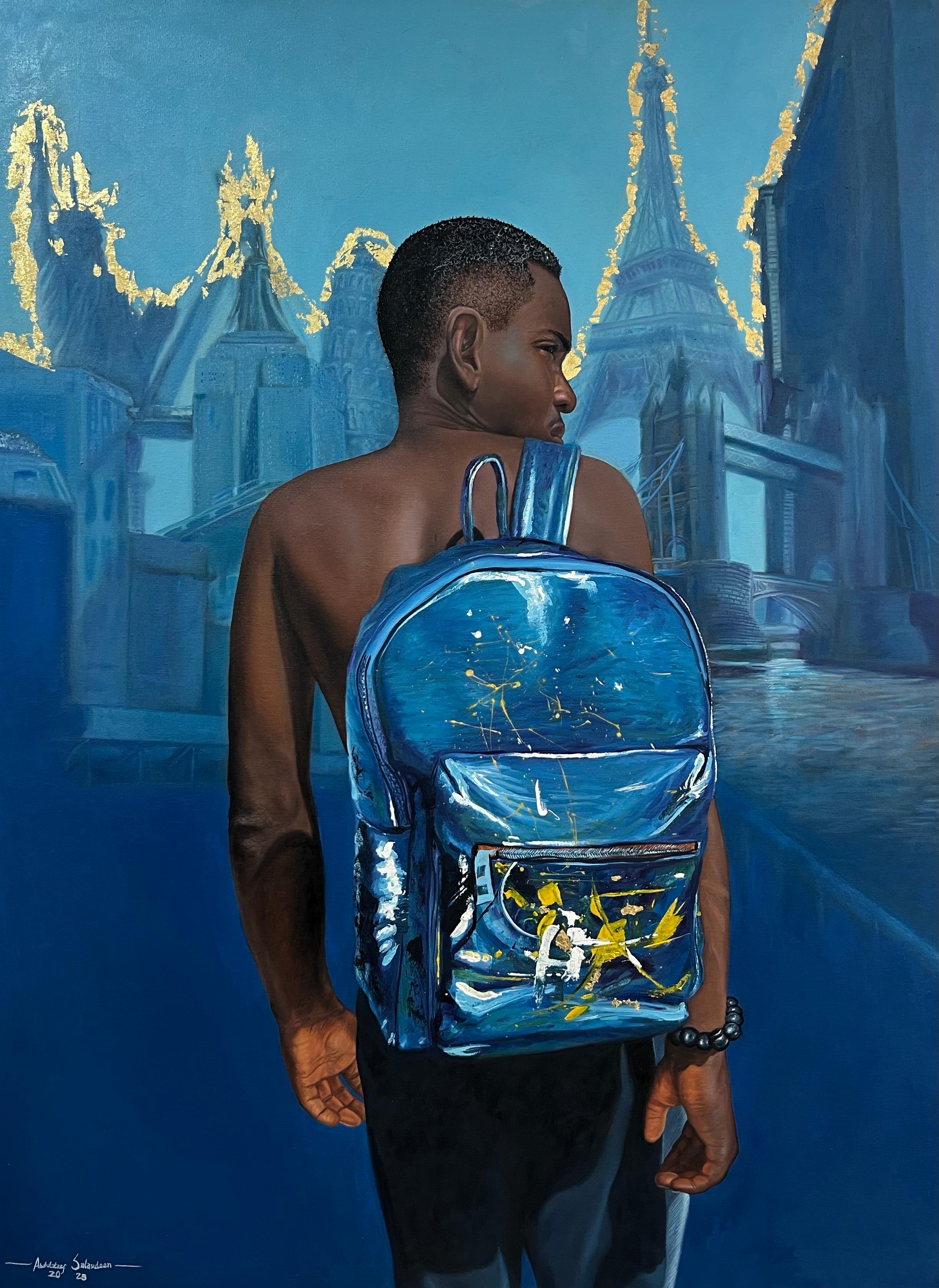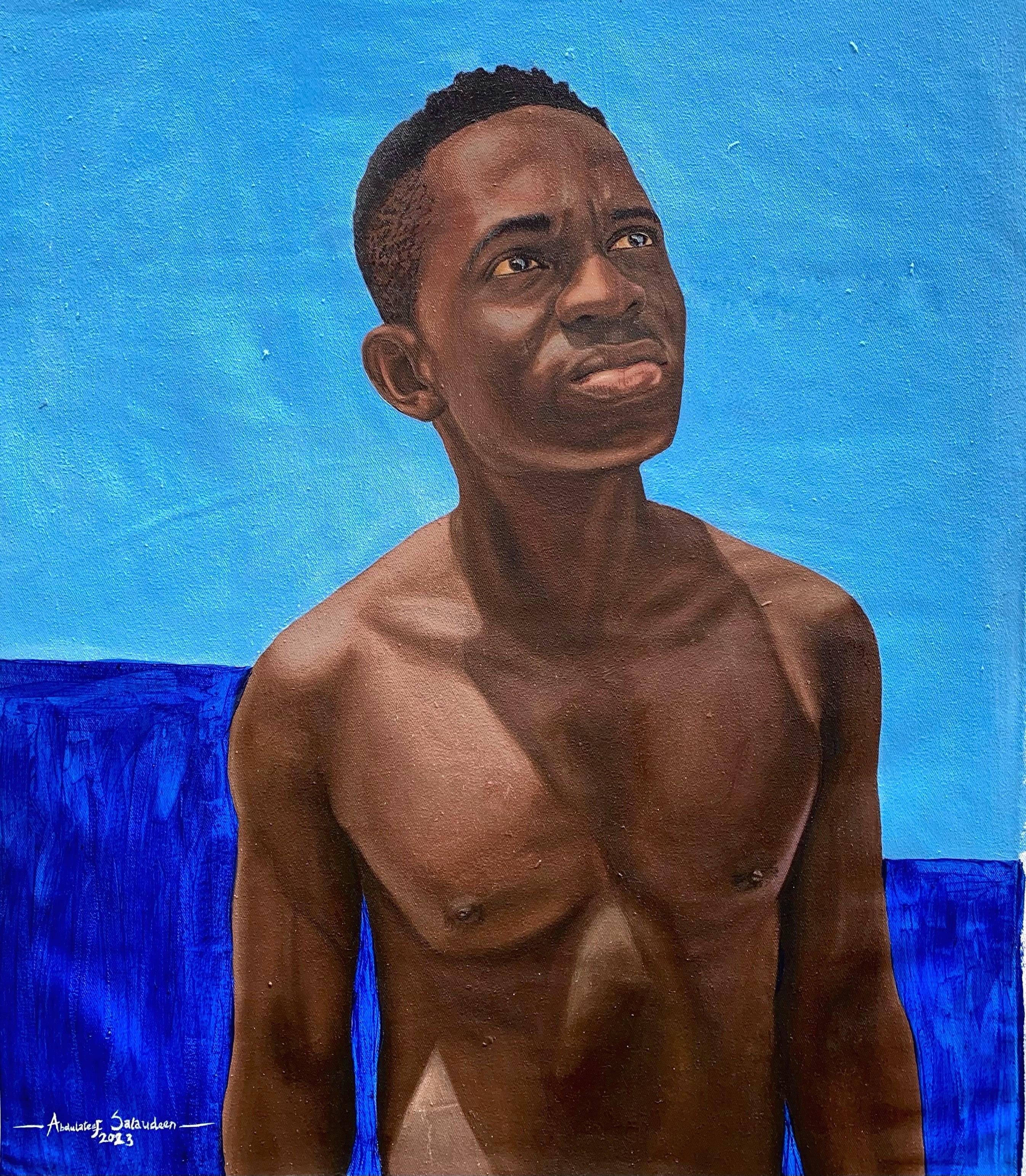Want more images or videos?
Request additional images or videos from the seller
1 of 10
Gustl StarkSmall Nude / - Abstract Figurativity -1946
1946
About the Item
Gustl Stark (1917 Mainz - 2009 ibid.), Small Nude, 1946. Oil on canvas, marouflaged, 54 x 25 cm (picture), 30 x 60 cm (frame), signed "Stark" top left, verso twice signed "Gustav Stark", inscribed by hand as "Small Nude" and dated by hand "1946". With label of the exhibition of the Bundeshaus Bonn from 1956.
- Rubbed area in the lower third of the body, at the same level a retouch in the ochre background. I provisional frame.
- Abstract Figurativity -
About the artwork
During the war, Gustl Stark suffered a particularly severe blow for an artist: he lost his right arm. Nevertheless, he continued to devote himself to art, and the painting, created in 1946, immediately after the end of the Nazi reign of terror, testifies to the dawn of a new era. At the same time, the work is a rare example of the artist's early figurative work, as Stark turned entirely to abstract painting as early as 1950. And even this painting is by no means purely figurative; rather, it already illustrates Stark's turn toward abstraction.
We see a female nude, but one that remains faceless. This can be read symbolically and in relation to the immediate past epoch, which, in the face of horrors, silences and blinds - literally renders faceless. In this sense, the figure is positioned to 'look back'. But she does not look. While this meaning may resonate and make the painting an important work of the immediate postwar period, Gustl Stark is primarily concerned with something else here, namely art itself. The absence of the face leads to the body becoming something flat. Due to the de-individualization, we do not see a concrete person with his individual features, but a body surface. And indeed, the body is constructed through an extremely planar design. Even the contour lines that form the corporeality have a planar rather than a linear character, especially where they merge into shadow zones of almost the same color. And the surfaces themselves are not modeled. The incarnate parts do not show any plastic gradations; the corporeality is completely withdrawn into the plane, which is also true for the hair. In addition, there is no uniform background against which the figure could appear; rather, the area next to the hair is kept bluish, creating a succession of earth-toned colored areas, which again binds the figure to the surface.
Last but not least, the flatness is also forced by the painting technique. Gustl Stark paints directly, a la prima, onto the coarse canvas, whereby the structure of the painting support remains visible in the picture, and in places - around the hair, for example - the canvas itself can be seen. This structural all-over lends the picture a certain flatness.
Gustl Stark thus uses the very motif that stands for the corporeality of art par excellence - the female nude - to transform the spatiality of the traditional picture into a flatness characteristic of modern art. And yet, a strong impression of corporeality is created, without being produced by a painterly modeling of the body. The oscillation between flatness and corporeality creates the intense tension of this groundbreaking painting.
In Gustl Stark's oeuvre, as a consequence of the abstraction we see here, the figurative is completely stripped away in a further step, which is also a loss when looking at this early key work.
About the artist
Gustl Stark was the son of a woodcarver and, after an apprenticeship as a decorative painter, attended the State School of Arts and Crafts in Mainz from 1936 to 1937. Although he was severely wounded in the war and lost his right arm, he studied at the Würzburg School of Painting and Drawing from 1943-1944 and then at the Academy of Fine Arts in Nuremberg from 1944-1948.
He won a state scholarship at the state art competition in Bad Ischl. Numerous study trips to Sylt, Paris, Switzerland, Austria, Italy, Holland and Belgium followed.
Gustl Stark worked in Mainz and was the first artist there to focus on abstract painting. His work quickly gained international recognition, including the Salon Réaliés Nouvelles in Paris.
From 1963-1970 he taught at the State University Institute for Art and Work Education in Mainz and from 1970-1975 at the Johannes Gutenberg University. Gustl Stark became particularly famous for his color embossed prints, for which he invented his own technique.
Gustl Stark received numerous awards for his work. He received the Art Prize for Painting of the City of Mainz in 1962, the State Prize of Rhineland-Palatinate in 1984, and the Gutenberg Bust of the City of Mainz in 1987.
Selected Bibliography
Hans Vollmer (Hrsg.): Allgemeines Lexikon der bildenden Künstler des XX. Jahrhunderts, Vierter Band, Leipzig 1958, S. 344.
Hans H. Hofstätter: Das malerische Werk Gustl Starks (= Kleine Schriften der Gesellschaft für bildende Kunst Mainz), Mainz 1962.
Wolfgang Venzmer: Zu Gustl Starks Prägetiefdrucken, Mainz 1982.
Gustl Stark: Prägetiefdrucke. Werkverzeichnis 1966-1990, Mainz 2003.
GERMAN VERSION
Gustl Stark (1917 Mainz - 2009 ebd.), Kleiner Akt, 1946. Öl auf Leinwand, maroufliert, 54 x 25 cm (Darstellung), 30 x 60 cm (Rahmen), oben links mit „Stark“, verso zweifach mit „Gustav Stark“ signiert, als „Kleiner Akt“ handbezeichnet und auf „1946“ handdatiert. Mit Aufkleber der Ausstellung des Bonner Bundeshauses aus dem Jahre 1956.
- beriebene Stelle im unteren Drittel des Körpers, auf derselben Höhe eine Retusche im ockerfarbenen Hintergrund. Im provisorischen Rahmen.
Exposé als PDF
- abstrakte Figürlichkeit -
zum Kunstwerk
Im Krieg erlitt Gustl Stark einen Schicksalsschlag, der für einen Künstler besonders schwerwiegend ist: Er verlor seinen rechten Arm. Dennoch widmete er sich auch weiterhin ganz und gar der Kunst und das 1946, unmittelbar nach dem Ende der nationalsozialistischen Schreckensherrschaft geschaffene Gemälde zeugt vom Aufbruch in eine neue Zeit. Zugleich ist das Werk ein rares Beispiel für das frühe figürliche Oeuvre des Künstlers, da sich Stark bereits ab 1950 ganz der abstrakten Malerei zuwandte. Und auch dieses Bild ist keineswegs rein figürlich, vielmehr veranschaulicht es bereits Starks Hinwendung zur Abstraktion.
Wir sehen einen weiblichen Akt, der jedoch gesichtslos bleibt. Dies mag symbolisch gelesen und auf die unmittelbar vergangene Epoche bezogen werden, die angesichts der Schrecken verstummen und erblinden lässt – förmlich gesichtslos macht. In diesem Sinne ist die Figur so positioniert, dass sie ‚zurückblickt‘. Aber sie blickt eben nicht. Mag dieser Bedeutungsgehalt auch mitschwingen, wodurch das Gemälde zu einem wichtigen Werk der unmittelbaren Nachkriegszeit wird, geht es Gustl Stark hier doch primär um etwas anderes, nämlich um die Kunst selbst. Das Fehlen des Gesichts führt dazu, dass der Körper zu etwas Flächenmäßigem wird. Aufgrund der Ent-Individualisierung sehen wir keine konkrete Person in ihren individuellen Zügen, sondern eine Körperfläche. Und tatsächlich ist der Körper durch eine äußerst flächenmäßige Gestaltung aufgebaut. Selbst die Konturlinien, die die Körperlichkeit formieren, weisen einen eher flächenmäßigen als linearen Charakter auf, insbesondere dort, wo sie in beinahe gleichfarbige Schattenzonen übergehen. Und die Flächen sind nicht in sich modelliert. Das Inkarnat weist keinerlei plastische Abstufungen auf; die Körperlichkeit ist ganz ins Flächenmäßige zurückgenommen, was in demselben Maße auch für die Haare gilt. Zudem gibt es keinen einheitlichen Hintergrund, der die Figur vor sich erscheinen lassen würde, vielmehr ist der Bereich neben den Haaren bläulich gehalten, so dass eine Abfolge an erdtonalen Farbflächen entsteht, wodurch die Figur abermals in die Fläche zurückgebunden ist.
Nicht zuletzt wird die Flächenmäßigkeit auch durch die Maltechnik forciert. Gustl Stark malt direkt, a la prima, auf die grobe Leinwand, wodurch die Struktur des Bildträgers im Bild sichtbar bleibt und stellenweise – etwa um die Haare herum – die Leinwand selbst zu sehen ist. Dieses strukturelle all-over verleiht dem Bild per se etwas Flächenmäßiges.
Gustl Stark bedient sich mithin gerade jenes Motivs, das für die Körperlichkeit der Kunst schlechthin einsteht – dem weiblichen Akt –, um die Räumlichkeit des traditionellen Bildes in eine für die moderne Kunst charakteristische Flächenmäßigkeit zu überführen. Und dennoch wird ein starker Eindruck von Körperlichkeit erzeugt, ohne dass diese jedoch durch eine malerische Modellierung des Körpers erzeugt worden wäre. Aus dem Oszillieren zwischen Flächigkeit und Körperlichkeit resultiert die intensive Spannung des wegweisenden Bildes.
Innerhalb von Gustl Starks Oeuvre liegt es in der Konsequenz der hier vor Augen stehenden Abstraktion in einem weiteren Schritt die Figürlichkeit gänzlich absteifen, was – auf dieses frühe Schlüsselwerk geschaut – aber auch einen Verlust bedeutet.
zum Künstler
Gustl Stark war der Sohn eines Holzschnitzers und besuchte nach einer Lehre als Dekorationsmaler von 1936-1937 die Staatsschule für Kunst und Handwerk in Mainz. Obwohl er im Krieg schwer verwundet worden war und seinen rechten Arm verloren hatte, studierte er von 1943-1944 an der Mal- und Zeichenschule Würzburg und anschließend, von 1944-1948, an der Akademie der bildenden Künste in Nürnberg.
Beim staatlich ausgelobten Kunstwettbewerb in Bad Ischl gewann er ein Staatsstipendium. Es folgten zahlreiche Studienreisen nach Sylt, Paris, in die Schweiz, nach Österreich, Italien Holland und Belgien.
Gustl Stark war in Mainz tätig und dort der erste Künstler, der sich der abstrakten Malerei widmete. Schnell fand sein Werk auch internationale Anerkennung, so beschickte er unter anderem den Salon Réaliés Nouvelles in Paris.
Von 1963-1970 lehrte er am Staatlichen Hochschulinstitut für Kunst- und Werkerziehung in Mainz und hatte von 1970-1975 einen Lehrauftrag an der Johannes-Gutenberg-Universität inne. Eine besondere Bekanntheit erlangte Gustl Stark durche seinen farbigen Prägedruck, für den er eine eigene Technik erfunden hatte.
Für sein Schaffen wurde Gustl Stark mit zahlreichen Auszeichnungen geehrt. Unter anderem erhielt er 1962 den Kunstpreis für Malerei der Stadt Mainz, 1984 den Staatspreis des Landes Rheinland-Pfalz und 1987 die Gutenberg-Büste der Stadt Mainz.
Auswahlbibliographie
Hans Vollmer (Hrsg.): Allgemeines Lexikon der bildenden Künstler des XX. Jahrhunderts, Vierter Band, Leipzig 1958, S. 344.
Hans H. Hofstätter: Das malerische Werk Gustl Starks (= Kleine Schriften der Gesellschaft für bildende Kunst Mainz), Mainz 1962.
Wolfgang Venzmer: Zu Gustl Starks Prägetiefdrucken, Mainz 1982.
Gustl Stark: Prägetiefdrucke. Werkverzeichnis 1966-1990, Mainz 2003.
- Creator:Gustl Stark (1917 - 2009, German)
- Creation Year:1946
- Dimensions:Height: 21.26 in (54 cm)Width: 9.85 in (25 cm)Depth: 1.58 in (4 cm)
- Medium:
- Movement & Style:
- Period:
- Condition:
- Gallery Location:Berlin, DE
- Reference Number:1stDibs: LU2438212632332

About the Seller
5.0
Vetted Seller
These experienced sellers undergo a comprehensive evaluation by our team of in-house experts.
Established in 2014
1stDibs seller since 2023
7 sales on 1stDibs
Typical response time: 7 hours
- ShippingRetrieving quote...Ships From: Berlin, Germany
- Return PolicyA return for this item may be initiated within 14 days of delivery.
More From This SellerView All
- The gift of flowersBy Conrad KieselLocated in Berlin, DEConrad Kiesel (1846-1921), The gift of flowers. Oil on wood, 43 x 35 cm, 69 x 61 cm (frame), signed at lower left "Conrad Kiesel pxt [pinxit]", about 1900. In a magnificent gilt stuc...Category
1890s Academic Nude Paintings
MaterialsOil
- Landscape with Trees by a Lake - Eternal summer silence over an abysmal lake -Located in Berlin, DEAndreas Thomas Juuel (1816 Copenhagen - 1868 Copenhagen). Summer landscape with tall deciduous trees by a lake. Oil on canvas, 54,5 x 42 cm (visible size), 71 x 58 cm (frame), signed...Category
1850s Realist Landscape Paintings
MaterialsOil
- Children with geese in the light of a summer eveningLocated in Berlin, DEMagda Kremer (*1942 Hengelo), Children with geese in the light of a summer evening. Oil on canvas, 40 x 50 cm (inside measurement), 52 x 62 cm (frame), signed by hand with "M.[agda] ...Category
Mid-20th Century Realist Figurative Paintings
MaterialsOil
- Two countrywomen with a donkey - Melancholy in an atmosphere of colour -Located in Berlin, DEPierre Louis De La Rive (1753 Geneva - 1817 Geneva). Two countrywomen with a donkey. Oil on canvas, mounted, 27 x 20 cm (visible size), 37 x 31 (frame), monogrammed "P.R." at lower right. About the artwork De La Rive has taken the typical scenes of Dutch landscape genre paintings...Category
1790s Old Masters Figurative Paintings
MaterialsCanvas, Oil
- Late Summer River Landscape / - Realistic Impression -By Jan Hillebrand WijsmüllerLocated in Berlin, DEJan Hillebrand Wijsmuller (1855 Amsterdam - 1925 ibid.), Late Summer River Landscape, oil on canvas, relined, 34 x 56 cm (inside measurement), 43 x 64 cm (frame), signed J[an] H[illebrand] Wijsmuller at lower right. - in good condition, the frame with isolated bumped spots - Realistic Impression - About the artwork The panoramic landscape format shows a river landscape, with the course of the river, which curves to the right, leading the eye into the depths of the picture and tempting it to continue the landscape in the imagination beyond the visible area. At the same time, however, the fact that the landscape is not visible through the bend in the river focuses our gaze on the entirety of the landscape depicted, without prompting us to focus on distant details. Accordingly, the brushstroke is not designed to render details with realistic precision. In the front left area of the river there is even a completely free brushwork, trained by Impressionism, which nevertheless remains committed to representational and convincingly suggests the movement of the water. Regardless of the distance of the observer, the entire picture is painted with the same broad brushstroke, so that the landscape is given as an impression. And yet this impression is not ephemeral, as in the case of French Impressionism, to put it exaggeratedly, but reveals to us the essence of the landscape in all its richness. This is why the Dutch variant of Impressionism is always also a realism, although the pictures appear less progressive, but still contain a dimension of landscape painting that is lost with progress. In the impression, the reality of the landscape is revealed, and this happens as we experience the landscape in the visual impression. Wijsmuller does not depict houses or people in order to allow the experience of the landscape to fully unfold. The experience is determined first and foremost by the river, which does not flow into the picture from our point of view, but towards us. Where the river begins to bend, the water is churned by a rapids. Toward us, the riverbed widens and the water comes to rest, covering the entire width of the foreground like a mirror. The stillness of the water corresponds to the evening mood of the late summer landscape, in which the warm tones of the evening light blend with the yellow and brown tones of the plants. A gentle, almost idyllic reality, carried by the brushstroke, yet animated by a liveliness that is also made visible by the brushstroke. The broad, dynamically placed brushstrokes evoke the movement of the treetops and animate even the immobile reeds, while the trunks on the right bank, executed in virtuoso white strokes that seem like markings, make the sunlight shine. On the other bank, a carpet of light also spreads out, its energetic effect again expressed in the brushstroke. The dynamic of the landscape is further enhanced by the complementary color contrasts between the greens, yellows, and browns on the one hand and the blue of the all-encompassing sky on the other. A contrast that is intensified by the reflection in the water. The evening coming to rest of the landscape is thus at the same time an all-encompassing contrasting and yet in itself harmonious movement. This reality becomes accessible to us as an experience in the impression of the landscape. About the artist Jan Hillebrand Wijsmuller entered the Royal Academy of Arts in Amsterdam in 1876 and studied under the innovative Professor August Allebé, who was famous for the Amsterdam Impressionism, also known as the Allebé School. In 1877, Wijsmuller transferred to the Hague Academy of Art, and thus to the Hague School, and then completed his studies at the Brussels Academy of Art. Returning to the Netherlands, Wijsmuller opened his own studio in Amsterdam. In 1883 he won the prestigious Young Artist Award, donated by Willink van Collen, which made Wijsmuller a well-known and sought-after artist. Wijsmuller was a member of the Societät Arti et Amicitiae Amsterdam and the Pulchri Studio in The Hague. Wijsmuller belongs to the second generation of the Hague School. While Vincent van Gogh described the protagonists of the first generation to his brother Theo as "the great gray people," the second generation, and Wijsmuller in particular, used a much more colorful palette. His oeuvre makes him a major player in Dutch Impressionism...Category
1890s Impressionist Landscape Paintings
MaterialsCanvas
- Mary Magdalene - Faith transforms inner into outer beauty and conquers death -By Balthasar DennerLocated in Berlin, DEBalthasar Denner (1685 Hamburg - 1749 Rostock). Mary Magdalene. Oil on copper, 37 × 32 cm (visible size), 45 x 40 cm (frame), signed and indistinctly dated "Denner 17(...)" at centre...Category
1720s Old Masters Figurative Paintings
MaterialsCopper
You May Also Like
- Painting (After Rubens)Located in Natchez, MSThis oil on canvas painting exemplifies the skill inherent in all of Girbent's work. The work, "Painting (After Rubens), is in fact a painting in the sty...Category
2010s Realist Figurative Paintings
MaterialsCanvas, Oil
- EmbersLocated in Denver, CO"Embers," is an original oil painting by Tenaya Sims. It is framed and ready-to-hang.Category
21st Century and Contemporary Realist Figurative Paintings
MaterialsCanvas, Oil
- TapestryLocated in Denver, CO"Tapestry," is an original oil painting by Tenaya Sims. It is framed and ready-to-hang.Category
21st Century and Contemporary Realist Figurative Paintings
MaterialsCanvas, Oil
- "Trust/Truth (Self Portrait)" Contemporary Figurative PaintingLocated in East Quogue, NYStunning monochromatic realistic contemporary figurative portrait painting by Sullivan Giles. Size 40 x 30 inches. Oil on canvas. The figures Giles depicts are often self-portraits...Category
2010s Realist Figurative Paintings
MaterialsCanvas, Oil
- Ajala Travel 1Located in Ibadan, Oyo"Ajala Travel" by Abdullateef Salaudeen is a captivating artwork that invites viewers into a world of wanderlust and exploration. The piece centers around a young man, adorned with a...Category
21st Century and Contemporary Realist Figurative Paintings
MaterialsCanvas, Oil, Acrylic
- Help is ComingLocated in Ibadan, OyoThis striking artwork captures the essence of a shirtless young man in a moment of profound contemplation. His gaze, both pained and optimistic, fixated upon an unseen horizon, offers a captivating entry point into the complex emotional narrative that underlies the piece. Salaudeen's use of color is masterful, drawing viewers' eyes immediately to the central figure. The young man's skin is rendered in a palette of subtle, earthy tones, emphasizing his vulnerability and humanity. The absence of a shirt lays bare his raw emotions and exposes the vulnerability we all share when facing adversity. However, it is the juxtaposition of the man's countenance that truly captivates the viewer. The artist has masterfully crafted an expression that is simultaneously heavy with the weight of the world and imbued with an undeniable glimmer of hope. The furrowed brow and furrowed lips are etched with the lines of a thousand struggles, yet his eyes betray a flicker of optimism. This duality is what makes "Help is Coming" so compelling; it encapsulates the human experience of confronting adversity, where pain and hope often intermingle in the most profound ways. The title, "Help is Coming," adds depth to the narrative woven into the piece. It suggests that, despite the pain etched onto the young man's face, there is a belief in a brighter future, a conviction that support and relief are on the horizon. This message resonates with viewers on a universal level, serving as a reminder that even in the darkest moments, there is the potential for change and improvement. Salaudeen's technique also deserves special mention. His meticulous attention to detail is evident in the fine lines and textures that make the young man's skin seem almost tangible. The background, although abstract and dreamlike, subtly hints at the broader context of the man's struggles, inviting viewers to interpret the piece through their own experiences and perspectives. "Help is Coming" is more than just a static image; it is a visual poem that speaks to the shared human experience of pain, resilience, and hope. It encourages us to reflect on our own journeys, reminding us that, no matter how daunting the challenges we face, there is always the potential for relief and redemption. In a world often filled with chaos and uncertainty, art has the power to provide solace and inspiration. Abdulateef Salaudeen...Category
21st Century and Contemporary Realist Figurative Paintings
MaterialsCanvas, Oil
